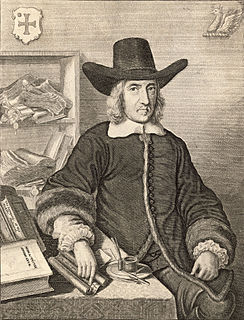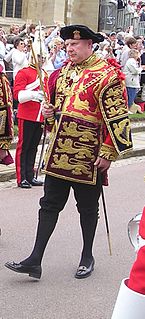 W
WThe Garter Principal King of Arms is the senior King of Arms, and the senior Officer of Arms of the College of Arms, the heraldic authority with jurisdiction over England, Wales and Northern Ireland. The position has existed since 1415.
 W
WJohn Anstis was an English officer of arms, antiquarian and politician who sat in the House of Commons between 1702 and 1722. He rose to the highest heraldic office in England and became Garter King of Arms in 1718 after years of political manoeuvring.
 W
WJohn Anstis was an officer of arms at the College of Arms in London.
 W
WSir George Rothe Bellew,, styled The Honourable after 1935, was a long-serving herald at the College of Arms in London. Educated at the University of Oxford, he was appointed Portcullis Pursuivant in 1922. Having been Somerset Herald for 24 years, he was promoted to the office of Garter Principal King of Arms in 1950, the highest heraldic office in England and Wales. He served in that capacity until his resignation in 1961. As Garter, Bellew oversaw the funeral of George VI, proclaimed the late King's daughter, Elizabeth II, as Queen and took a leading role in the organisation of her Coronation in 1953. After his retirement, Bellew was Secretary of the Order of the Garter and Knight Principal of the Imperial Society of Knights Bachelor. He lived for many years at Dower House in Old Windsor, Berkshire, but later moved to Farnham and died in 1993, aged 93.
 W
WRalph Bigland was an English officer of arms, antiquarian and cheesemaker. He was born at Stepney, Middlesex, and was the only son of Richard Bigland and his wife, Mary. His father was a native of Westmorland, descended from the Bigland family of Biglands. He should not be confused with his nephew Sir Ralph Bigland.
 W
WThomas Browne (1708–1780), Garter Principal King of Arms, the second son of John Browne of Ashbourne, Derbyshire, became Bluemantle Pursuivant in 1737, Lancaster Herald in 1743, Norroy and Ulster King of Arms in 1761, and Garter in 1774 until his death.
 W
WWilliam Bruges was an English officer of arms. He is best remembered as the first person appointed to the post of Garter King of Arms, which is currently the highest heraldic office in England.
 W
WSir Alexander Colin Cole was a long serving officer of arms at the College of Arms in London. Eventually, he would rise to the rank of Garter Principal King of Arms, the highest heraldic office in England.
 W
WSir Gilbert Dethick, FSA was a long-serving English Officer of Arms at the College of Arms in London. He would eventually rise to the highest heraldic office in England and serve as Garter Principal King of Arms.
 W
WSir William Dethick was a long-serving officer of arms at the College of Arms in London. He was the son of Sir Gilbert Dethick and followed his father as Garter Principal King of Arms. Though he was adjudged a qualified armorist and antiquarian, Dethick's biography is notable for numerous instances of conflict with his colleagues and others.
 W
WSir William Dugdale was an English antiquary and herald. As a scholar he was influential in the development of medieval history as an academic subject.
 W
WSir Peter Llewellyn Gwynn-Jones was a long-serving Officer of Arms at the College of Arms in London. He was Garter Principal King of Arms, the senior English officer of arms, from 1995 to 2010.
 W
WSir Isaac Heard was a British officer of arms who served as appointed Garter Principal King of Arms, from 1784 until his death in 1822 the senior Officer of Arms of the College of Arms in London. In this role, he oversaw several notable cases and also officiated at all the funerals of the Royal family.
 W
WSir Algar Henry Stafford Howard was a long-serving officer of arms at the College of Arms in London. He was the third consecutive Fitzalan Pursuivant of Arms Extraordinary to attain the highest rank at the College of Arms.
 W
WStephen Martin Leake was a numismatist and long-serving officer of arms at the College of Arms in London.
 W
WSir Alfred Scott Scott-Gatty was a long serving officer of arms at the College of Arms in London and a successful composer.
 W
WSir William Segar was a portrait painter and officer of arms to the court of Elizabeth I of England; he became Garter King of Arms under James I.
 W
WSir Anthony Richard Wagner was a long-serving Officer of Arms at the College of Arms in London. He served as Garter Principal King of Arms before retiring to the post of Clarenceux King of Arms. He was one of the most prolific authors on the subjects of heraldry and genealogy of the 20th century.
 W
WSir Edward Walker was an officer of arms and antiquarian who served as Garter King of Arms.
 W
WSir Gerald Woods Wollaston was a long-serving officer of arms at the College of Arms in London. Wollaston's family had a firm tradition at the College of Arms. Wollaston's great-grandfather was Sir William Woods, Garter Principal King of Arms from 1838 until his death in 1842. His grandfather was Sir Albert William Woods who held the same post from 1869 to 1904.
 W
WThomas Woodcock, Garter Principal King of Arms, is a member of the Royal Household and the senior herald and genealogist at the College of Arms in London.
 W
WSir Thomas Wriothesley was a long serving officer of arms at the College of Arms in London. He was the son of Garter King of Arms, John Writhe, and he succeeded his father in this office.